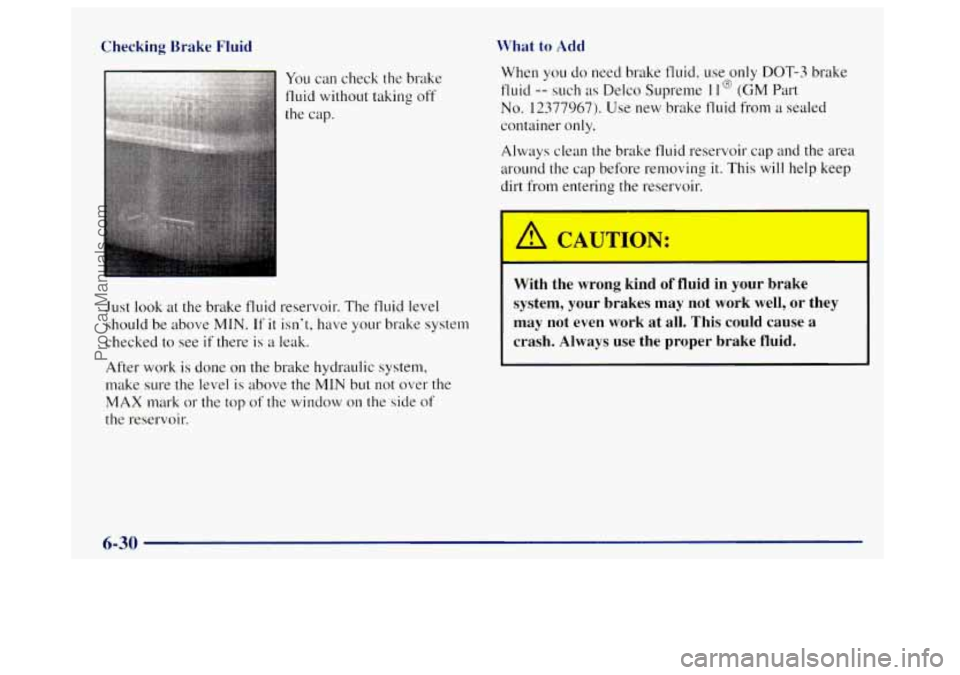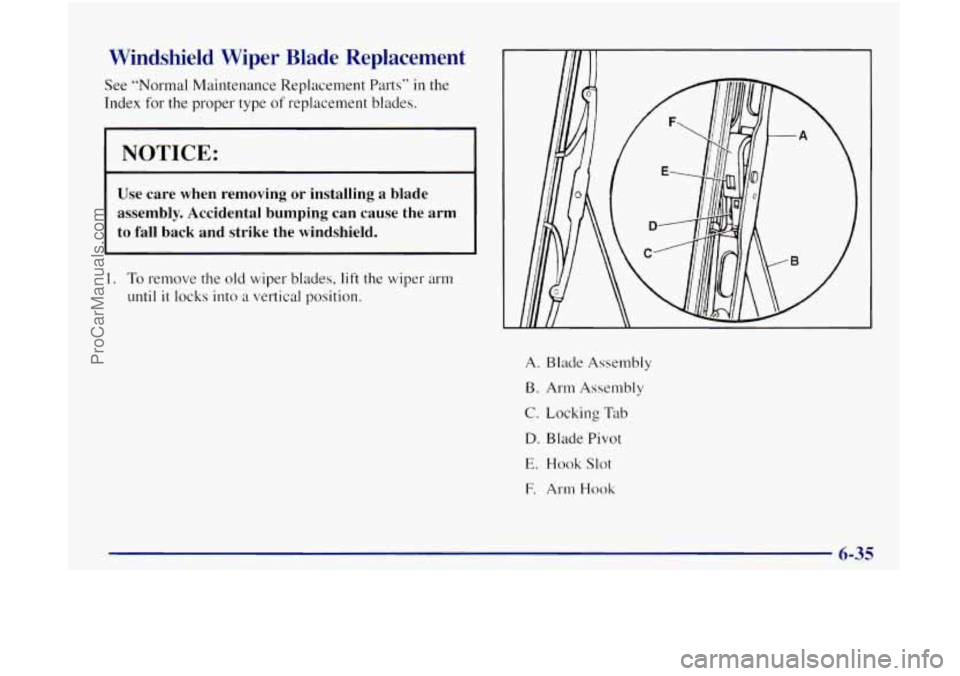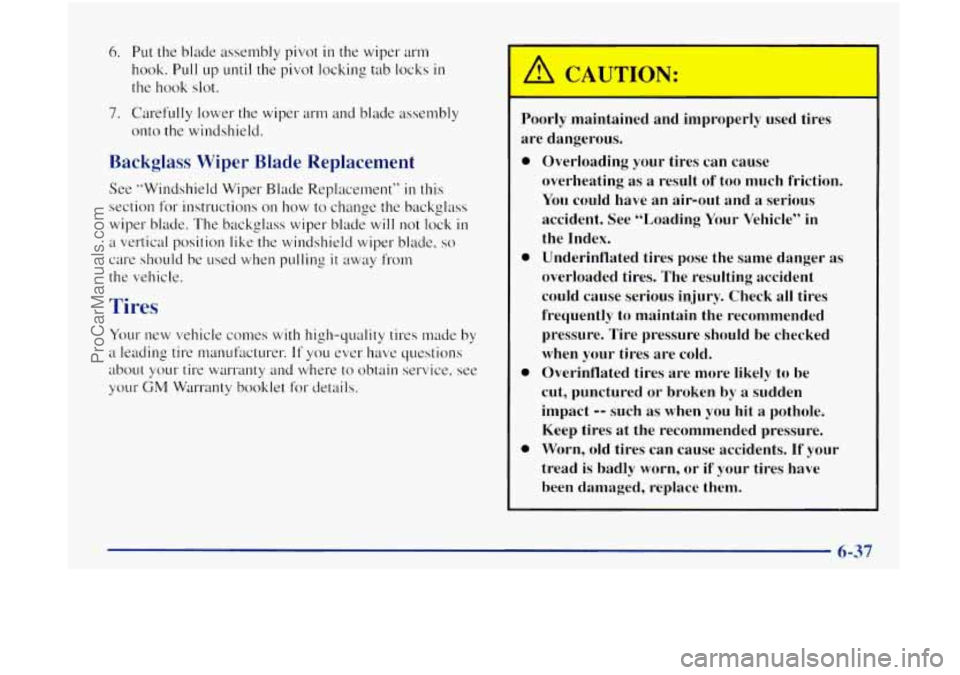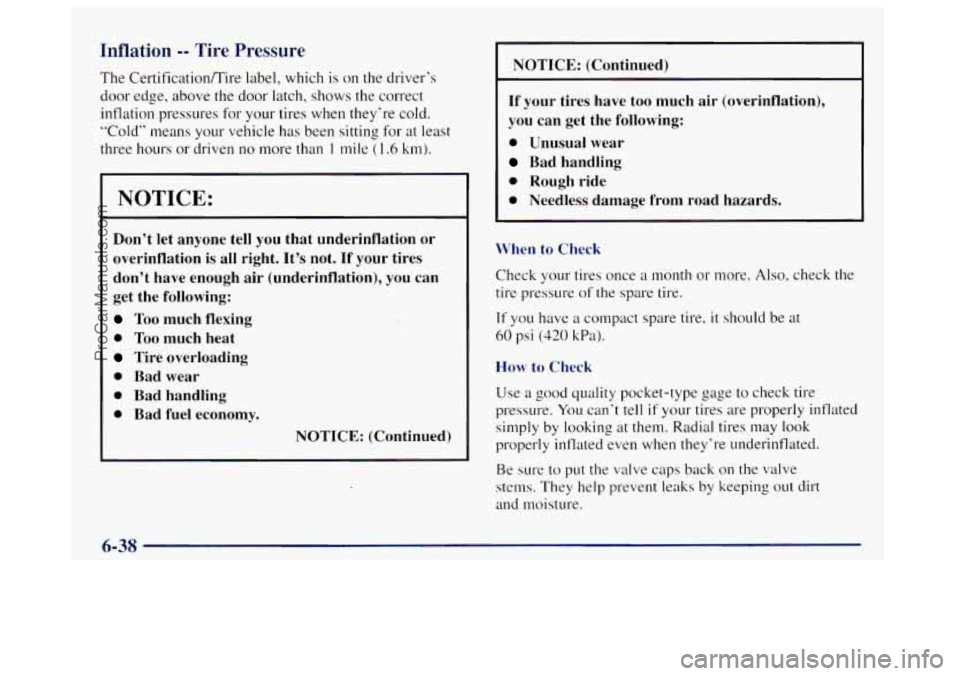OLDSMOBILE BRAVADA 1998 Owners Manual
Manufacturer: OLDSMOBILE, Model Year: 1998, Model line: BRAVADA, Model: OLDSMOBILE BRAVADA 1998Pages: 380, PDF Size: 19.2 MB
Page 271 of 380

Brakes
Brake Fluid
of the brake system. If it is, you should have yo~~r brake
system tlxed, since
a leak nleans that sooner or later your
brakes won't work well, or won't work at
all.
So. it isn't a good idea to "top oft'' your brake fluid.
Adding brake fluid won't correct
a leak. If you add fluid
when your linings are worn, then you'll have too much
fluid when you get new brake linings. You should add
(or remove) brake fluid, as necessary, only when work is
done on the brake hydraulic system.
Your brake master cylinder reservoir is here.
It is filled
with DOT-3 brake fluid.
There are only two reasons
why the brake fluid level in the
reservoir might go down. The first is that the brake fluid
goes down to an acceptable level during norlnal brake
lining weal-. When new linings are
put in, the fluid level
goes back up. The other reason is that fluid is leaking out
If you have too much brake fluid, it can spill on
the engine. The fluid
will burn if the engine is
hot enough. You or others could be burned,
and your vehicle could be damaged. Add brake
fluid only when work
is done on the brake
hydraulic system.
Refer to the Maintenance Schedule to determine when to
check your brake fluid. See "Periodic Maintenance
Inspections"
in the Index.
6-29
ProCarManuals.com
Page 272 of 380

Checking Brake Fluid
Just look at the brake fluid reservoir. The fluid level
should be above
MIN. If it isn't, have your brake system
checked to see
if there is a leak.
After work
is done on the brake hydraulic system,
make sure the level is above the
MIN but not over the
MAX mark or the top of the window on the side of
the reservoir.
What to Add
When you do need brake fluid, use only DOT-3 brake
fluid
-- such as Delco Supreme 1 I@ (GM Part
No. 12377967). Use new brake fluid from a sealed
container only.
Always clean the brake fluid reservoir cap and the area
around the cap before removing
it. This will help keep
dirt from entering the reservoir.
With the wrong kind of fluid in your brake
system, your brakes may not work well, or they
may not even work at all. This could cause a
crash. Always use the proper brake fluid.
6-30
ProCarManuals.com
Page 273 of 380

NOTICE:
0
0
Using the wrong fluid can badly damage
brake system parts. For example, just a few
drops of mineral-based oil, such as engine
oil, in your brake system can damage brake
system parts
so badly that they’ll have to be
replaced. Don’t let someone put in the
wrong kind of fluid.
If you spill brake fluid on your vehicle’s
painted surfaces, the paint finish can be
damaged. Be careful not to spill brake fluid on your vehicle. If you do, wash it off
immediately. See “Appearance Care” in
the Index.
Brake Wear
Your vehicle has four-wheel disc brakes.
Disc brake
pads have built-in wear indicators that make a
high-pitched warning sound when the brake pads are worn
and new pads are needed. The sound may come and go or
be heard
all the time your vehicle is moving (except when
you are pushing
on the brake pedal firmly).
The brake wear warning sound means that soon
your brakes won’t work well. That could lead to
an accident. When you hear the brake wear
warning sound, have your vehicle serviced.
1
1 NOTICE:
Continuing to drive with worn-out brake pads
could result in costly brake repair.
ProCarManuals.com
Page 274 of 380

Some driving conditions or climates may cause a brake
squeal when the brakes are first applied or lightly
applied. This does not mean something is wrong with
your bra
cz k es.
Properly torqued wheel nuts are necessary to help
prevent brake pulsation. When tires are rotated, inspect
brake pads for wear and evenly torque wheel nuts
in the
proper sequence to
GM specifications.
Brake linings should always be replaced as complete
axle sets.
See “Brake System Inspection” in Section
7 of this
manual under Part
C “Periodic Maintenance
Inspections.’’
.e Pedal Travel
See your retailer if the brake pedal does not return to
normal height, or
if there is a rapid increase in pedal
travel. This could be a sign
of brake trouble.
Brake Adjustment
Every time you make a brake stop, your disc brakes
adjust for wear.
Replacing Brake System Parts
The braking system on a modern vehicle is complex.
Its many parts have to be
of top quality and work well
together
if the vehicle is to have really good braking.
Your vehicle was designed and tested
with top-quality
GM brake parts. When you replace parts of your braking
system
-- for example, when your brake linings wear
down and you have to have new ones put in
-- be sure
you get new approved
GM replacement parts. If you
don’t, your brakes may no longer work properly. For
example, if someone puts in brake linings that are wrong
for your vehicle, the balance between your front and
rear brakes can change
-- for the worse. The braking
performance you’ve come
to expect can change in many
other ways
if someone puts in the wrong replacement
brake parts.
Battery
Every new vehicle has a Delco Freedom@ battery. You
never have to add water to one of these. When it’s time
for
a new battery, we recommend a Delco Freedom
battery. Get one that has the replacement number shown
on the original battery’s label.
6-32
ProCarManuals.com
Page 275 of 380

Vehicle Storage Halogen Bulbs
If you’re not going to drive your vehicle for 25 days or
more, remove the black, negative
(-) cable from the
battery. This
will help keep your battery from
running down.
CAUTION:
Batteries have acid that can burn you and gas
that can explode. You can be badly hurt if you
aren’t careful. See “Jump Starting” in the Index Halogen
bulbs have pressurized gas inside and
can burst
if you drop or scratch the bulb. You or
others could be injured. Be sure to read and
follow the instructions on the bulb package.
Composite Headlamps
for tips on working around a battery without
getting hurt. 1. Open the hood.
2. Remove the black retainer clips by lifting up.
I I
3. Pull the headlamp assembly out.
Contact your retailer to learn how to prepare your
vehicle for longer storage periods.
Also, for your audio system, see ”Theft-Deterrent
Feature”
in the Index.
Bulb Replacement
Before you replace any bulbs, be sure that all the lamps
are off and the engine isn’t running. See ”Replacement
Bulbs”
in the index for the proper type of bulb to use.
4. Unplug the electrical connector.
5. Turn the bulb assembly to the left to remove it.
6. Put the new bulb assembly into the headlamp
assembly and turn
it to the right until it is tight.
1. P~LI~ in the electrical connector.
8. Put the headlamp lens assembly back into the
vehicle. Install the two retaining clips.
ProCarManuals.com
Page 276 of 380

Front Turn Signal Lamps
1. Remove the headlamp assembly as shown earlier in
this section.
2. Twist the bulb socket to remove it from the
headlamp assembly.
3. Pull the bulb straight out to remove it from
the socket.
4. Push the new bulb into the socket until it snaps
into place.
5. Put the bulb socket into the lamp assembly and twist
it to the right until it is tight.
Taillamps
1. Open the endgate.
2. Remove the two screws
from the lamp assembly.
1 6. Put the headlamp assembly back into the vehicle.
Instill
the two retaining clips.
3. Pull the assembly away from the vehicle.
4. Turn the socket to the left to remove it. Push the ta
in while you turn the socket to the left.
out of the socket.
5. Holding the base of the bulb, pull the bulb straight
6. Push the new bulb straight into the socket until it clicks.
7. Put the socket into the lamp assembly and turn the
8. Install the lamp assembly and screws.
9. Close the endgate. socket to
the right
~lntil it locks into place.
6-34
ProCarManuals.com
Page 277 of 380

Windshield Wiper Blade Replacement
See “Normal Maintenance Replacement Parts” in the
Index
for the proper type of replacement blades.
I NOTICE:
Use care when removing or installing a blade
assembly. Accidental bumping can cause the arm
to fall back and strike the windshield.
1. To remove the old wiper blades, lift the wiper arm
until it locks into a vertical position.
A. Blade Assembly
B. Arm Assembly
C. Locking Tab
D. Blade Pivot
E. Hook Slot
F. Arm Hook
ProCarManuals.com
Page 278 of 380

2.
3.
Press down on the blade assembly pivot locking tab.
Pull down on the blade assembly to release it from
the wiper arm hook.
Remove
the insert from the blade assembly. The
insert has two notches at one end that are locked by
the bottom claws of the blade assembly. At the
notched end, pull
the insert from the blade assembly.
A
I I
0
4. To install the new wiper insert, slide the insert (D),
notched end last, into the end with two blade
claws
(A). Slide the insert all the way through the
blade claws at the opposite end
(B). The plastic caps
(C) will be forced off as the insert is fully inserted.
5. Be sure that the notches are locked by the bottom
claws. Make sure that
all other claws are properly
locked on both sides of the insert slots.
C
A. Claw in Notch
B. Correct Installation
C. Incorrect Installation
6-36
ProCarManuals.com
Page 279 of 380

6. Put the blade assembly pivot in the wiper arm
hook. Pull up until the pivot locking tab locks in
the hook slot.
7. Carefully lower the wiper arm and blade assembly
onto
the windshield.
Backglass Wiper Blade Replacement
See “Windshield Wiper Blade Replacement“ in this
section
for instructions on how to change the backglass
wiper blade. The backglass wiper blade
will not lock in
a vertical position like the windshield wiper blade, so
care should be used when pulling it away from
the vehicle.
Tires
Your new vehicle comes with high-quality tires made by
a leading tire manufxturer. If you ever have questions
about your tire warranty and where to obtain service, see
your
GM Warranty booklet for details.
A c; TTmT .ON:
Poorly maintained and improperly u5 - __ tires
are dangerous.
0
0
0
0
Overloading your tires can cause
overheating
as a result of too much friction.
You could have an air-out and a serious
accident. See “Loading Your Vehicle” in
the Index. Underinflated tires pose the same danger as
overloaded tires. The resulting accident could cause serious injury. Check
all tires
frequently to maintain the recommended
pressure. Tire pressure should be checked when your tires are cold.
Overinflated tires are more likely to be
cut, punctured or broken
by a sudden
impact
-- such as when you hit a pothole.
Keep tires
at the recommended pressure.
Worn, old tires can cause accidents. If your
tread is badly worn, or if your tires have
been damaged, replace them.
6-37
ProCarManuals.com
Page 280 of 380

Inflation -- Tire Pressure
The CertificatiodTire label, which is on the driver’s
door edge, above the door latch, shows the correct
inflation pressures for your tires
when they’re cold.
“Cold” means your vehicle has been sitting for
at least
three hours or driven no more than
1 mile (I .6 km).
NOTICE:
Don’t let anyone tell you that underinflation or
overinflation is all right. It’s not. If your tires
don’t have enough air (underinflation), you can
get the following:
Too much flexing
0 Too much heat
Tire overloading
0 Bad wear
0 Bad handling
0 Bad fuel economy.
NOTICE: (Continued)
I NOTICE: (Continued) I
If your tires have too much air (overinflation),
you can get the following:
0 Unusual wear
Bad handling
0 Rough ride
0 Needless damage from road hazards.
When to Check
Check your tires once a month or more. Also, check the
tire pressure
of the spare tire.
If you have a compact spare tire, it should be at
60 psi (420 kPa).
How to Check
Use a good quality pocket-type gage to check tire
pressure.
You can’t tell if your tires are properly inflated
simply by looking at them. Radial tires may
look
properly inflated even when they’re underinflated.
Be sure to put the valve
caps back on the valve
stems. They help prevent leaks
by keeping out dirt
and moisture.
6-38
ProCarManuals.com